Hello! I just wanted to create this post to give people who are interested in reading an idea of what it has been like using Kitsun to go through「君の膵臓を食べたい」.
The Good
- Hours upon hours of time saved
I don’t really even know how to quantify how much time that I’ve saved thanks to the dictionary feature within Kitsun. I used to spend most of my time looking up words and creating personal flashcards out of them, but I definitely spend most of my time learning and studying my new words now. When the deck for the book is lacking, the dictionary feature easily picks up the slack.
-
Most of the words in the collection that appear are correct and in order
-
Few glaring mistakes
-
I’m currently through 35% of the book and am able to understand ~95% of the content!
-
I set a goal to finish reading the book within 1 year, and it looks I’ll be able to finish a few months early.
I’m really surprised by this since I started reading this book as a level 20 account coming from WaniKani, so I really didn’t know much at all when I started reading.
- Direct translation of chapters 1-3! (80 pages!!!)
This one was and is still a really big pain in the butt. I started doing this just to check my understanding, but it became something much more. I’m still not super confident in what I’ve done so far, but I’m always going back over things and making it better. Overall, it’s something fun to do when I have the time.
The Bad
- I think that it’s absolutely necessary to have siblings rank up separately if you’re interested in anything outside of reading. This means Japanese-Reading, Japanese-English, and English-Japanese decks for the vocabulary.
This is something that I wish I changed way earlier. When I was about 30% in the book, I was able to read through the text well and understand, but I found that my ability to recall English-Japanese was terrible. If you’re only interested in reading this is not really an issue, but if you want to use the words in conversation, the way the words spoil each other when you study them leads you to become weaker in some areas. I should add that I opted to combine the Japanese-Reading and Japanese-English layouts.
- The number of parsing errors/omitted vocabulary is far greater than I imagined.
I’ve been working with this deck for approximately 6 months now and still use it every time I study the text, but the errors have been becoming more and more apparent with how the text is parsed and developed into flash cards. Currently, the parsing method misses what seems to be 90% of idioms and onomatopoeia/と-adjectives. In addition to the other parsing errors and such, I would estimate that about 40% of the words in this book are missing from the deck. As you can imagine, this means that you’ll have to spend quite a bit of time looking up definitions and adding the missing words to an additional deck. Thankfully, the dictionary feature exists, which makes it incredibly easy to add the missing words to a new deck.
- I wanted to read to also learn everyday conversation, but the main character in the book uses a lot formal language.
Has nothing to do Kitsun, but this kinda sucked because it made going through the text much harder than I originally anticipated. It’s a good challenge, but it seems like so many of the words are obscure.
Future Plans
Overall, I’m really happy with what I’ve been able to do using Kitsun over the past 6 months and I can’t wait for future updates/improvements!  After I finish reading the book, I may attempt to finish the direct translation so that other people can have an easier time understanding the grammar and funky phrasing. The English I’ve written does sound a bit strange since I’ve tried to do a 1:1 translation for the most part, but I think the goal for now is to allow people to form a greater understanding of the Japanese writing. I can’t wait to see how the reading tool continues to evolve and become more and more helpful.
After I finish reading the book, I may attempt to finish the direct translation so that other people can have an easier time understanding the grammar and funky phrasing. The English I’ve written does sound a bit strange since I’ve tried to do a 1:1 translation for the most part, but I think the goal for now is to allow people to form a greater understanding of the Japanese writing. I can’t wait to see how the reading tool continues to evolve and become more and more helpful.
Also, after 「君の膵臓を食べたい」I’m planning to read 「人間失格」by 太宰治 using the reading tool. So excited!


 I wonder if this could be done, since it’s a deck posted by Kitsun and it has so many users in it.
I wonder if this could be done, since it’s a deck posted by Kitsun and it has so many users in it. 

